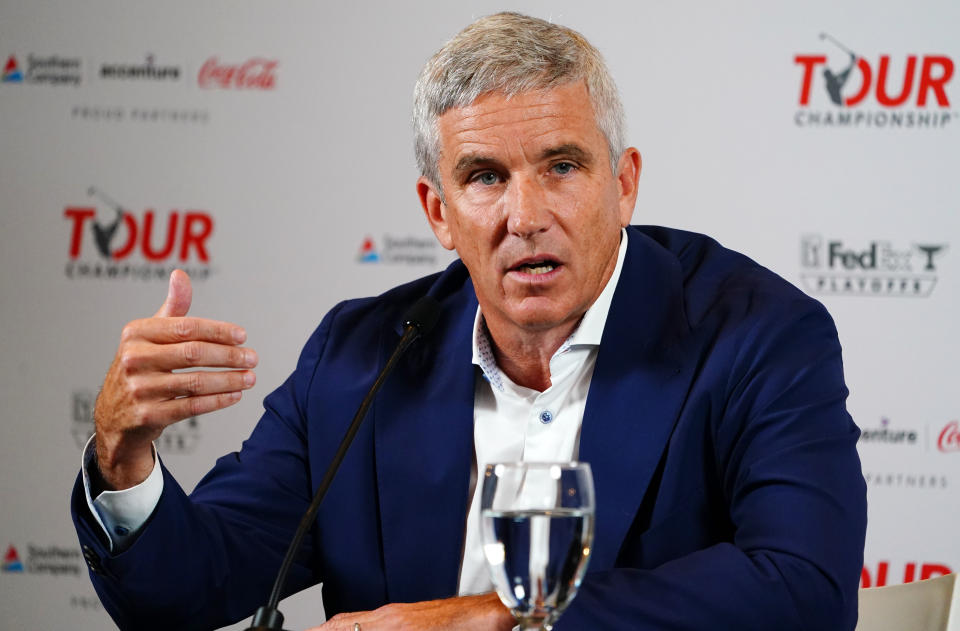What’s next: Breaking down the impact of extending PGA Tour, Saudi PIF and investor negotiations

After a year of uncertainty, 2024 was meant to usher in a new era of professional golf following the shocking announcement last June that the PGA Tour, DP World Tour and Saudi Arabia’s Public Investment Fund – the financial backer of the rival LIV Golf – had agreed to merge their commercial assets to create a new, for-profit golf entity.
Golf fans have come to realize over the last six months that the framework agreement was nothing more than a good way to end litigation and a bad way to announce plans to form a new venture, known as PGA Tour Enterprises, to reunite the professional game.
A Dec. 31 deadline was set to reach an agreement, but on Sunday night, PGA Tour commissioner Jay Monahan sent a memo to players that stated “active and productive” negotiations would continue into 2024 with the PIF based on the progress made to date. Monahan also claimed the Tour has “made meaningful progress” with the Strategic Sports Group (SSG), an outside investment group headlined by Fenway Sports Group.
So … now what? As the PGA Tour returns to action this week, golf fans are still left to wonder what the future of the sport will look like. The New Year’s Eve update provided little information and left fans with numerous unanswered questions that need to be addressed, sooner rather than later. Until then, let’s put on our speculation hats and look at the impact extending the deadline may have on the pro game.
Will LIV or the Tour’s 2024 seasons be affected?

As it stands now, nope. While LIV has yet to fully announce its 14-event schedule or 12-team rosters for the new season, the league is set to tee off its first event next month in Mexico. The Tour returns to a calendar-year schedule later this week in Hawaii. Both sides are continuing to operate separately as competitors, as seen with their conflicting events and LIV’s recent signing of Jon Rahm, while also discussing how to unite forces behind the scenes. For now, it’s business as usual, which is chaos.
The role of outside investors

Since the announcement of the framework agreement, the Tour was flooded with interest from groups who also wanted to invest in the pro game. On Dec. 10, the Tour’s policy board announced it had advanced discussions with the SSG and that it had not shut the door on the PIF.
But if the PIF is so rich with its billions of dollars, why bring more cooks into the kitchen?
For a few reasons. First, follow the money. Rich people often enjoy doing business with other rich people because it usually means they’re going to make more money. What’s better than $3 billion? $7 billion, which is how much money could be involved according to ESPN.
An optimist could argue that bringing in outside investors is a way to make the deal more palatable given the U.S. government’s various questions. On the flip side, a pessimist could view the move as a way for the Tour to have its cake and eat it, too, by pushing the Saudis out after ending the litigation. The former seems more realistic and would be a step towards reuniting the game, while the latter would be another pivot from the Tour that would only lead to more battles with LIV.
Speaking of LIV, does it have a future if the framework agreement is passed?

That depends on who you ask. The agreement stated that LIV’s future would be decided by the PGA Tour based on an “empirical data-driven evaluation” and that Monahan and the board would “determine the ongoing plan and strategy,” but LIV officials, including Norman himself, have pushed back on this notion.
The deadline extension opens the door and gives LIV more time to poach players, which is important for the league seeing as its 12-team rosters still aren’t full with a little more than 30 days until its first event. Al-Rumayyan loves the idea of team golf, and even though fans haven’t flocked to LIV just yet, the concept has proven to be successful, especially at the season-ending Team Championship (though the interest in that event can largely be chalked up to the inclusion of a match-play format).
Expect some version of LIV or team golf to be part of PGA Tour Enterprises if a deal is agreed on and then passed. If there’s no deal, it’s safe to assume LIV will venture on and continue to be a rock in the Tour’s shoe.
What will PGA Tour Enterprises even look like?

This is the multi-billion-dollar question. Integrating the LIV and Tour schedules as is won’t be easy, and concessions will need to be made on both sides. In the memo sent to players on New Year’s Eve, Monahan said, “These partnerships will allow us to unify, innovate and invest in the game for the benefit of the players, fans and sponsors.”
That all sounds great. But how will that be achieved?
Given LIV’s struggles to run a smooth operation and the Tour’s inability to manage its interests between top players and rank-and-file members, should we have confidence that the two sides can work together to create something the fans want to watch? Some parts of LIV have been good, but the concept hasn’t caught on as quickly as organizers would’ve hoped. The TGL was supposed to be a big step for the Tour, but it ended up as a faceplant.
Missing the Dec. 31 deadline could have a significant impact on when PGA Tour Enterprises gets off the ground, as well. Let’s say an agreement had been reached, that would have given LIV another full year to prove its worth and the powers that be plenty of time to iron out what the future of the tours and PGA Tour Enterprises would look like. The longer the negotiations take, the worse off we all will be. A divided game overshadowed by uncertainty isn’t good for anyone.
Should we even take the framework agreement seriously anymore?
It’s been surprising to see how quiet LIV and the PIF have been with regard to the framework agreement over the last few months given the interest from outside investors. The Tour has controlled the messaging with its updates to players and has been upfront by making more information public to fans, which shouldn’t come as a shock given the fallout from the surprise announcement of the agreement and the backroom dealings that took place to produce it.
But at this point, it’d be naïve to view the framework agreement as gospel given the material change in negotiations with the inclusion of outside investors. It was initially vague for a reason, and while that might help the powers that be, it’s causing headaches for those of us who just want to watch the best golfers in the world compete against each other.

